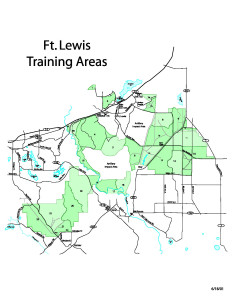 Saturday Nathanael Swecker led a trip of 11 ABC birding club members to check out new areas and to learn to navigate part of his Joint Base Lewis McChord (JBLM) e-Bird patch. Nathanael has been very prominent in the Pierce County birding scene over the last couple of years with several posts most weeks from various areas of JBLM. Nathanael often finding birds the rest of us had no idea were available on the military post. He has focused his birding in the 3+ years since he became an avid birder on the JBLM ranges, and has decided to undertake studying and documenting on e-Bird the JBLM avifauna.
Saturday Nathanael Swecker led a trip of 11 ABC birding club members to check out new areas and to learn to navigate part of his Joint Base Lewis McChord (JBLM) e-Bird patch. Nathanael has been very prominent in the Pierce County birding scene over the last couple of years with several posts most weeks from various areas of JBLM. Nathanael often finding birds the rest of us had no idea were available on the military post. He has focused his birding in the 3+ years since he became an avid birder on the JBLM ranges, and has decided to undertake studying and documenting on e-Bird the JBLM avifauna.
Ten ABC birders met Nathanael at 6AM at the Roy “Y” park-and-ride, where he showed us excellent topographic maps of the JBLM area, complete with range map borders, and gave us our agenda for the day. This is a link to the Range brochure with a simple map. To be allowed onto the JBLM ranges to bird it is first necessary to obtain a no-charge range pass from the JBLM Range Control Office. In order to know what areas are open birders need to check on the range control website to see what ranges are open.
Many of us have birded the Spanaway Marsh, but our first stop today was a look at this area from a completely different direction. Most birders access the marsh from the turn-around at the south end of 176th Street near the intersection with Pacific Ave. We instead went to the back of Training area 9. We took a right-hand turn just beyond the railroad crossing after the Roy Gate Road entrance to Chambers Lake. We entered there, then took one more right turn onto Transmission Line Road. This accessed the rear side of the marsh. This approach allows excellent places to view much bigger areas of open water on the marsh than are visible from the 176th St. approach., We saw Wood Ducks, barn swallows, and a good mix of autumn passerines.
Our next stop was at Chambers Lake. I learned that tis area is really just the area very close to the lake, and that many areas I had thought were all part of the Chambers Lake area are considered parts of other Training Areas that often are not open when Chambers Lake is listed as open. We took a nice walk on the road on the back side of the lake. This is found by taking a left off the main road past the water level control bridge, and after a short distance parking to walk the road right beside the lake. Like the back approach to Spanaway Marsh we had much better unobstructed water visibility than we could have from the front side of the lake. A minimum of 80 wood ducks, an unexpected flock of 8 Blue-winged teal, various other waterfowl, three Red-breasted sapsuckers, and a variety of other usual birds were seen here.
The third stop of the day was JBLM Area 15. This is a part of the larger area known as the 13th Division Prairie. Nathanael explained to us that the 13th Division Prairie covers much of 3 JBLM training areas. Typically area 14 is almost never open to visitors, and the access is often limited to only area 15 and sometimes area 13. Area 14 is the large open prairie area where JBLM biologists monitor the endangered Streaked subspecies of Horned Lark and limit access. In area 15 we found bluebirds, a Peregrine falcon hunted over area 14 visible from the road, and we found both Sharp-shinned and Cooper’s hawks. We learned about ways to visit the Muck Creek riparian corridor from a vantage new to most of us.
We are grateful to Nathanael for showing us how he birds how his “patch” on JBLM I look forward to his promise to start a website on JBLM birding soon
You can see the e-bird lists for the trip. We totaled 58 species.
